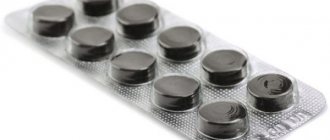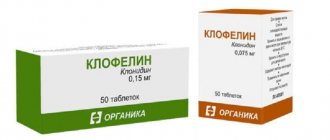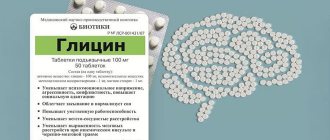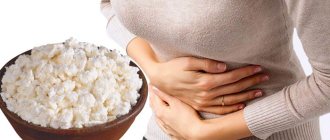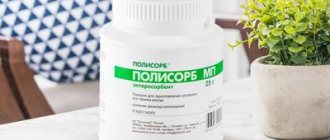The most common causes of sudden onset of diarrhea are food poisoning or intestinal infections, which can be caused by pathogenic viruses, bacteria, protozoa or fungi entering the gastrointestinal tract. For bacterial intestinal infections, antibiotics must be present as part of complex treatment. They are also used for severe food poisoning. Such drugs include Levomycetin (or Chloramphenicol), which has long been used in medical practice. Levomycetin for diarrhea is prescribed mainly to adults, since it can cause serious side effects in children.
Method of using Levomycetin
Levomycetin for oral administration is available in the form of round tablets with a pale yellow color. The drug belongs to the group of antibiotics, therefore, it is necessary to drink it at regular intervals so that the required concentration of the active substance is maintained in the body, which will lead to the fastest possible death of the pathogens. Levomycetin should be taken on an empty stomach, half an hour before meals. In some cases, these tablets can cause nausea, then they should not be taken on an empty stomach; take them about an hour after meals. The dosage, frequency and duration of administration are determined only by the attending physician. The tablets are swallowed whole, there is no need to chew them, just wash them down with plenty of water.
Overdose
Severe complications from the hematopoietic system are usually associated with the use of Levomycetin for a long time and in high doses (over 3,000 milligrams per day). In this case, the following symptoms of overdose develop:
- pale skin;
- sore throat and elevated body temperature;
- bleeding and hemorrhage;
- fatigue or weakness.
A sign of an overdose is the “gray syndrome”; with a partial overdose, the following pathologies and symptoms may be observed:
- acidosis;
- bluish-gray skin color;
- coma;
- irregular breathing;
- low body temperature;
- cardiovascular failure;
- decreased nervous reactions;
- myocardial conduction disturbance;
- circulatory collapse.
“Gray syndrome” can also occur in patients with impaired kidney and liver function. This reaction is the result of the accumulation of the active substance in the human body when the content of the component in the blood exceeds 50 micrograms per 1 milliliter.
If any complications from the above list develop, you must immediately stop taking the drug. In some cases, symptomatic therapy may be required:
- gastric lavage;
- taking saline laxatives and/or activated charcoal;
- cleansing enema;
- hemosorption.
How to take Levomycetin correctly for diarrhea?
Taking medications for diarrhea, including Levomycetin, must be coordinated with your doctor, as this may affect the patient’s health. The specialist calculates the duration of treatment and the required dose of the drug based on the patient’s health status, his age and the presence of concomitant diseases. On average, the course of treatment is 7-14 days.
As a rule, the patient’s well-being returns to normal within a day after starting to take the drug, but this does not mean that treatment should be stopped. On the contrary, the course of treatment with antibacterial drugs must be completed to destroy all pathogenic bacteria. Each package of Levomycetin contains complete instructions, which indicate all the necessary information regarding its use. In particular, the annotation states that the drug should be prescribed only after examining the patient by a specialized specialist.
The tablets should be taken half an hour before meals or an hour after meals, and they must be swallowed whole without chewing and washed down with a sufficient amount of liquid. Tablets taken on an empty stomach can cause nausea and pain in the abdominal area; in this case, it is recommended to postpone their intake to the afternoon, which will not affect the effectiveness of treatment at all.
The frequency of taking the drug for adults is usually once every 5-6 hours. But it should be taken into account that the daily dose should not exceed 2 grams of the active substance. In exceptional cases, the doctor may double the dosage; this usually happens if, in addition to diarrhea, the patient experiences repeated vomiting. However, such treatment must be carried out exclusively under the supervision of a specialist, since the risk of intoxication of the body increases.
If diarrhea is mild and is not burdened by accompanying symptoms, then the drug intake can be reduced to 1-2 times. If the patient’s well-being does not return to normal after such treatment, then it is necessary to contact a specialized specialist who, based on the diagnosis, can recommend another drug.
Description
This antibiotic was initially isolated from an actinomycete culture, and only then was a synthetic substitute invented, and the production of the drug was put into production. The year in which the drug was developed was 1947.
The active ingredient in diarrhea tablets "Levomycetin" is chloramphenicol. It consists of colorless crystals with a bitter taste. The tablets themselves are pure white or slightly yellowish. Each contains from one quarter to one second gram of active ingredient, this depends on the form of release of the drug.
How to take Levomycetin for the treatment of diarrhea (diarrhea) in adults
This drug is intended to treat diarrhea and should be taken as recommended by a doctor. The tablets should be taken before meals or an hour after meals. The dosage of the drug for an adult should not exceed 2 grams of chloramphenicol per day, and this amount should be divided into 3-4 doses. An intestinal infection of high severity may be a reason to double the dosage from the permissible amount.
Levomycetin is quickly absorbed from the digestive tract into the bloodstream, where its maximum amount is observed within a couple of hours after taking the drug. The effect of using this medicine is about 4-5 hours. Levomycetin can lead to various side effects, therefore, while taking it, the patient's condition should be constantly monitored through a general blood and urine test.
Please note that treatment with this drug should not be interrupted even if all symptoms of the disease have disappeared, as this may lead to the remaining bacteria becoming resistant to chloramphenicol. And this often becomes the cause of a relapse of the disease or its transition to a chronic form.
Indications and contraindications
Medicines are prescribed for the following conditions:
- typhoid fever,
- salmonellosis,
- paratyphoid,
- blepharitis,
- keratitis,
- conjunctivitis,
meningitis,
- brucellosis,
- tularemia.
The drug is contraindicated in the following conditions:
- inhibition of hematopoiesis,
- fungal infections,
- psoriasis,
- hypersensitivity to the elements included in the drug.
The medication is prohibited from use:
- during breastfeeding,
- during pregnancy,
- newborns.
The medicine is not recommended for use in infectious diseases, sore throat. At the same time, it is not used with barbiturates, differin, or cytostatics.
Levomycetin for diarrhea (diarrhea) in children
Taking Levomycetin is allowed in childhood, however, the dosage is calculated depending on the age and weight of the small patient. For children under three years of age, the daily dose of the drug is 15 mg per kilogram of body weight. In this case, it should be divided into 3-4 doses. At the age of 3 to 8 years, the daily dosage is 200 mg, and for children over eight years old - 300 mg.
It should be noted that Levomycetin has a rather unpleasant, bitter taste, so taking it in childhood can be difficult. In this case, it is recommended to purchase Levomycetin-actitab, which is completely tasteless, which does not in any way affect its effectiveness.
The admissibility of treating diarrhea with Levomycetin, especially in childhood, is currently causing a lot of controversy. Most experts agree that it should be used only in exceptional cases, when nothing else is available. In this case, you should be prepared for side effects, for example, nausea, vomiting, stool upset, a sharp decrease in blood pressure, general weakness and microflora disturbances in the future. Levomycetin is not a harmless drug, so its use should be carried out exclusively under the supervision of a specialist. The lack of treatment results should be the reason for the child’s immediate hospitalization in an infectious diseases hospital, where he will undergo all the necessary diagnostic procedures, which will allow him to develop a different, more effective course of therapy.
How can I replace chloramphenicol®?
It is important to understand that the use of antibiotics for acute intestinal infections, as for any other diseases, must be justified. Antibacterial therapy is mandatory for bloody type diarrhea (that is, diarrhea is accompanied by the release of bloody mucus or streaks of blood) and for cholera (secretory type diarrhea).
Antibacterial therapy is also advisable for high (uncontrollable within 24 hours) fever, severe diarrhea, severe acute intestinal infections (caused by Shigella, Salmonella or Escherichia), complicated salmonellosis, as well as acute intestinal infections in patients with immunodeficiency conditions.
We invite you to familiarize yourself with the best ways to treat warts at home
If you have severe diarrhea, severe abdominal pain, fever and dehydration, call an ambulance immediately. A mandatory indication for emergency hospitalization is the patient's age under three years. The fact is that young children develop severe dehydration extremely quickly, leading to a decrease in circulating blood volume, blood thickening, electrolyte imbalance, kidney dysfunction, etc.
Attempts to independently treat children in the first years of life are extremely dangerous and can lead to death.
Dosage of the drug, how to use Levomycetin correctly
In each specific case, the duration of treatment, frequency of tablets and dosage are determined only by the attending physician, depending on the severity of the disease and concomitant pathologies. However, the annotation for the drug specifies an approximate treatment regimen. So, adults need to take Levomycetin 250-500 mg every 6-8 hours. In severe cases of the disease, the dose is doubled, but not more than 3 grams of the drug per day. Such treatment should be carried out exclusively in a hospital setting under constant medical supervision. On average, the duration of treatment with Levomycetin is 7-10 days. But if necessary and there are no side effects, the treatment course is extended to two weeks.
Compound
As the instructions indicate, the active ingredient is Chloramphenicol - a crystalline snow-white powder with a slight amber tint. It is a synthetic antibiotic. Has a bitter taste. Helps cope with various diseases. Almost insoluble in water. Contains 80%.
The following is used as excipients:
- Potato starch - used to strengthen the tablet. It is a snow-white or amber-colored powder. It has a homogeneous consistency. Does not have a pronounced odor. Refers to semi-finished products. Extracted from natural potato tubers.
- Medical low molecular weight PVP is povidone. It is an insoluble form of low molecular weight polyvinylpyrrolidone. Developed as an enterosorbent. May have a detoxifying effect. Able to bind toxins in the body.
- Calcium stearate is a calcium salt of stearic acid. It contains synthetic fatty acids. It is produced in the form of a homogeneous snow-white powder with a slight amber tint. Non-toxic.
This drug is available in the form:
- Eye drops 0.25% solution. 1 ml of this product contains 2.5 mg of the main active substance.
- Bottles for droppers, available in 5 and 10 ml.
- Special powder for the production of injection suspension. Each container must contain 500 or 1000 mg of the main active substance.
- Round tablets of snow-white color with a slight amber tint. Tablets contain 0.5 and 0.25 of the main active substance.
The main active ingredient of the drug is chloramphenicol. The medicine is available in the form of tablets and powder. So, Levomycetin tablets are 10 pieces in a contour package.
Each tablet may contain 250 or 500 mg of the active ingredient. Levomycetin also contains additional substances. The powder is used to prepare injections. 1 bottle contains 500 or 1000 mg of active substance.
Other drugs have a similar composition - for example, Levomycetin Actitab, Levovinisol, Chloramphenicol.
Treatment of diarrhea with Levomycetin, how to properly treat diarrhea
Such an unpleasant symptom as diarrhea often occurs as a result of infection of the body with all kinds of pathogenic microorganisms. In this case, the use of Levomycetin is completely justified, because it is a broad-spectrum antibacterial drug, and therefore, most pathogens of infectious diseases are sensitive to it. Taking this drug gradually leads to cleansing of the body from bacteria that provoked the appearance of diarrhea, and, accordingly, the loose stool itself stops. However, we should not forget that Levomycetin is an antibiotic, therefore, it is necessary to approach such treatment with all responsibility, namely: maintain equal time intervals between doses of the drug and not stop the course of treatment unless absolutely necessary. Otherwise, pathogenic microorganisms become accustomed to the active substance of the drug and the development of a chronic form of the disease is likely.
general information
Due to the fact that diarrhea is a polyetiological symptom, that is, a variety of reasons can lead to its occurrence, it is necessary to be examined before treatment. Stool analysis will help to accurately identify the provoking factor. There has long been an opinion among people that Levomycetin is a quick and effective remedy for diarrhea. High efficiency and availability made it the first remedy in the fight against diarrhea.
Levomycetin is an antibacterial agent with a wide spectrum of bacteriostatic action, belonging to the amphenicol group. This means that the active substance suppresses the activity of pathogenic microorganisms, slowing growth and development. In addition, the product also has a bactericidal effect, that is, it leads to the complete death of the infectious agent.
The mechanism of action of the drug is due to a violation of protein synthesis in cells. The product is available in various dosage forms. In ophthalmology, chloramphenicol eye drops are widely used for keratitis, conjunctivitis and blepharitis. The medicine is also available in powder form for the preparation of suspensions and vials for droppers.
The following pathogens are especially sensitive to the active component of Levomycetin:
- staphylococci,
- streptococci,
- coli,
- enterococci,
- pneumococci,
- salmonella,
- shigella,
- Klebsiella
The drug is prescribed even in cases where pathogens have shown resistance to Penicillin, Streptomycin and sulfonamides. Protozoa, Pseudomonas aeruginosa, clostridia, as well as acid-fast bacteria and some strains of staphylococci show resistance to the effects of the drug. The tablets are effectively used in the complex therapy of dysentery, salmonellosis, enterocolitis, typhoid fever, and cholera.
Levomycetin for children
Of course, only parents can decide which drugs to treat their child with. However, Levomycetin belongs to the group of antibiotics and to take it, you should conduct the necessary laboratory tests, as well as consult with a competent specialist. It is also worth considering the occurrence of side effects, such as urticaria, diarrhea, headache, decreased body defenses, impaired vision and hearing. In addition, only a doctor will be able to take into account all contraindications for taking this drug and prescribe the optimal dosage if necessary. Therefore, you should not self-medicate; a child’s health is not the place for experiments.
Side effects
The drug is also not without side effects. The most serious and dangerous of them are:
- aplastic anemia;
- "gray syndrome";
- suppression of bone marrow function.
Pills can have a negative effect on many human organs and systems. In this regard, other side effects are divided according to the localization of the manifestation of undesirable effects.
On the part of the psyche and nervous system, the drug can cause:
- headache;
- delirium;
- visual and auditory hallucinations;
- disturbance of the sense of taste;
- optic and peripheral neuritis (including paralysis of the eyeballs);
- disorders of voluntary movements, facial expressions and pantomimes;
- deterioration of hearing and vision;
- lack of clarity and coherence of thinking;
- moderate depression;
- encephalopathy.
The following pathologies and syndromes can develop in the gastrointestinal tract
- bloating;
- glossitis;
- dysbacteriosis;
- dyspepsia;
- irritation of the mucous membrane of the oral cavity and pharynx;
- vomit;
- stomatitis;
- nausea;
- inhibition of intestinal microflora;
- worsening diarrhea;
- enterocolitis.
Cost of the drug Levormycetin
Demand creates supply - this is how representatives of factories producing Levomycetin explain the strong increase in prices for this drug in recent years. The more than affordable price has increased by 400-500%, which is completely incomprehensible, because on the shelves of pharmacies there is now a large selection of similar medicines, many of which are much more effective. Most likely, the majority of the population of our country buys Levomycetin out of habit, because it has been used for decades and has proven itself well.
Availability
This product can be purchased without a specialist prescription.
The medicine must be stored in a dark place, direct exposure to the sun should be avoided. The optimal storage temperature is 18-25°C. The shelf life of the tablets is 36 months. Eye drops are stored for no more than 24 months. The shelf life of the powder for injection suspension is 48 months. Once opened, the medicine must be used within 30 days.
We invite you to watch a video about this drug.
Levomycetin reviews of the drug for the treatment of diarrhea
Elena: For as long as I can remember, since childhood, there have been Levomycetin tablets in our home medicine cabinet. And they saved the whole family from diarrhea more than once. Moreover, the hospital was located in another locality and it was not always possible to get there, especially with repeated loose stools. Thus, Levomycetin was our lifesaver and, fortunately, no one in our family ever experienced side effects.
Ivan: Without exaggeration, this drug once saved my life. During a family vacation at sea, my wife and I decided to try cold smoked fish. They took it straight from their hands, of course, there was no question of any quality certificate, but it looked very appetizing. As a result, the next day I began to have severe diarrhea, and, of course, dehydration. It’s good that there were Levomycetin tablets in the medicine cabinet and a few hours after I started taking them, I felt much lighter, and the next day I was able to pack my things and go home. The holiday turned out to be memorable.
Intestinal disorder
Diarrhea is the common name for diarrhea, familiar to both children and adults, characterized by loose and profuse stools, sometimes with a frequency of bowel movements up to 15 times per day. Urges and “walks” provoke pathogenic microorganisms that enter the human body through:
- poorly washed hands;
- unwashed berries and fruits, stale food;
- unboiled water.
For diarrhea, chloramphenicol is prescribed, since the phenomenon itself is not dangerous to health, but its consequences (dehydration) are dangerous. Often manifestations of diarrhea are associated with chronic diseases (Crohn's syndrome, ulcerative colitis) and stress. But chloramphenicol should be taken only for diarrhea of infectious etiology.



